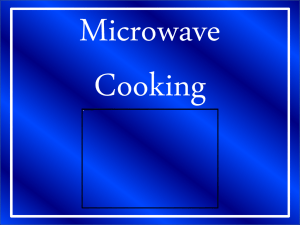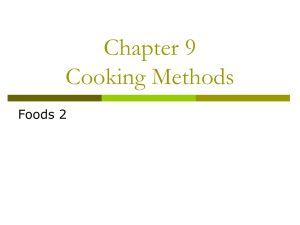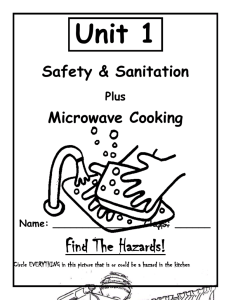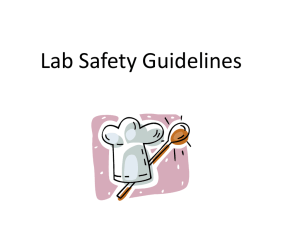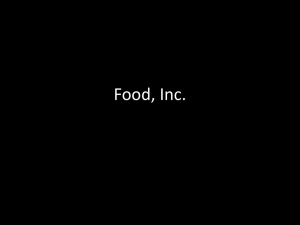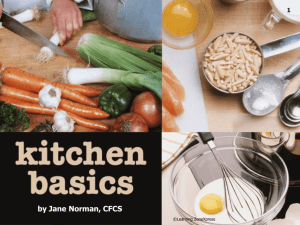kitchen basics powerpoint
advertisement
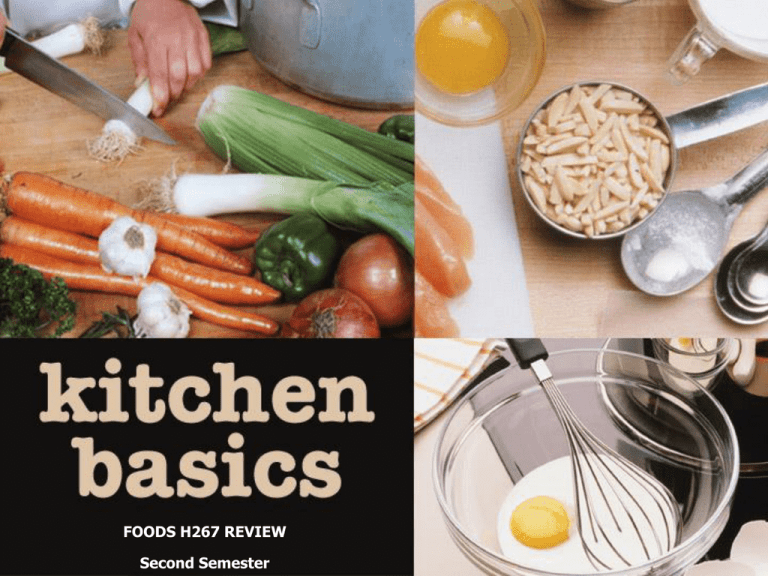
FOODS H267 REVIEW Second Semester 2 Learning the Basics What you need to know before you cook! • Know Your Kitchen – Appliances, Tools & Equipment • How to Follow a Recipe – Cooking & Mixing Terms – Measuring & Abbreviations • Personal & Food Safety • Clean Up! 3 Kitchen Equipment Cooking and baking tools and utensils save time and energy. • Make sure all utensils are durable and are easy to clean. Learn how to use these tools for best results: • Cutting & Serving • Mixing • Baking - in the oven • Cooking - on the stovetop 4 Cutting & Serving Tools tongs knives vegetable peeler grater can opener ladle serving 5 Mixing Tools Pancake Turner/Spatula Measuring Tools: Wooden Spoon Dry Measuring Cups Wire Whisk Liquid Measuring Cups Rubber Scraper Measuring Spoons Rotary Beater Pastry Blender Rolling Pin Mixing Bowls Strainer/Colander 6 Baking Tools bread/loaf pan cake pan cookie sheet Muffin Pan 10” X 15” Jelly Roll Pan 9” X 13” Rectangular Baking Pan Pie Pan 7 Cooking Tools Small saucepan Medium saucepan Dutch Oven Small Skillet Large Skillet Casserole Dishes stir fry pan (wok) 8 Time-Saving Small Appliances Special Equipment used in Class: Waffle Iron Stand Mixer Pasta Maker Blender Griddle Slow Cooker Toaster Deep Fryer Ice Cream Maker Food Processor 9 Know How To Follow A Recipe It is important to know some basic cooking terms and how to measure ingredients accurately when preparing foods. Most recipes list ingredients and directions in the order that they occur. Follow the recipe step-by-step. To Get Good Results From a Recipe: • • • • Read the recipe carefully. Get all utensils, tools and ingredients ready. Measure accurately. Follow directions!!!! 10 Measuring Dry Ingredients For dry ingredients including flour, sugar, and salt, use dry measuring cups & spoons. • Heap • Level dry measuring cups • Empty measuring spoons 11 Measuring Solid Ingredients For solid ingredients including peanut butter, shortening and brown sugar use dry measuring cups. • Pack • Level • Empty 12 Measuring Liquids For liquid ingredients including milk, water, oil, and juice, use liquid measuring cups. • Set cup on a flat surface. • Bend down to eye level and pour until the desired mark is reached. liquid measuring cup 13 Using Measuring Spoons Use measuring spoons to measure small amounts of dry and liquid ingredients. Do not use kitchen spoons, they are not accurate. How to measure the following: • 3/4 tsp. Salt • 3 tsp. Vanilla 14 Abbreviations Do you understand these abbreviations? teaspoon tsp. or t. Tablespoon Tbsp.or T. cup c. pint pt. quart qt. ounce oz. pound lb. or # few grains f.g. Fahrenheit F 15 Equivalents From small to large measurements: 1 Tbsp. = 3 tsp. 1 c. = 16 Tbsp. 2 c. = 1 pt. 4 c. = 1 qt. 16 c. = 1 gal. 2 pt. = 1 qt. 4 qt. = 1 gal. 16 Cooking Terms Just a few of hundreds of terms: Cutting & Peeling: Core Cube Chop Pare Dice Slice Peel Mince Mixing: Beat Fold Combine Blend Stir Strain Cream Whip Cut in 17 Cooking Terms Using the Stovetop: Baste Fry Brown Boil Simmer Stir-Fry Braise Sauté Preheat Bake Roast Preheat Broil Grill Using The Oven: Using The Microwave: Cooking Time Rotate Standing Time 18 GAS STOVETOP COOKING •Please check knobs are off! •Easy to bump gas on—BE CAREFUL! •When cleaning, pick up burners and clean under 19 Microwave Ovens Read the manual and know how to operate your microwave properly. • Using & Caring for Microwave Ovens: – Do not turn on a microwave when empty. – Use only microwave safe cookware, like glass, ceramic, plastic and paper. Do not use metal cookware or wires or metallic-edged dishes. – Clean the interior and exterior after use, including door seal. • Safety Tips: – Always use a hot pad, dishes become hot in the microwave from the food. – Pierce certain foods before cooking (i.e. potatoes, hotdogs). – Remove cover so steam flows away from your face. 20 Microwave Ovens Use your microwave to thaw, cook, reheat and save preparation time. • Microwave Cooking Tips: – The higher the wattage the shorter the cooking time. – Vent one side of plastic wrap cover to allow moisture to escape. – Standing time allows food to continue cooking. – Use paper towels to prevent spattering. – Stir during cooking time. – Foods that need to boil, such as pasta, rice, lentils and dry beans, will not cook faster in a microwave. 21 Safety in the Kitchen A Must When Cooking! Did you know that more accidents happen in the kitchen than any other room in the house? Safety can be divided into two very important areas: • Personal Safety in the kitchen. • Food Safety - preventing food-borne illnesses. 22 Food Safety Preventing Food-Borne Illnesses: • A food-borne illness is an illness transmitted by food. • Millions of cases of food-borne illnesses occur in the U.S. each year. Many go unreported because people mistake their symptoms for the “flu”. A food borne illness can result in one of two ways: • Contaminants – substances that have accidentally gotten into food. • Bacteria – micro-organisms that multiply and under certain conditions can cause people to get sick. • Cross Contamination—transfer of bacteria from utensils to food due to improper handling 23 Types of Food Borne Illnesses Bacterial illnesses • Caused by ingesting bacteria or the toxins (poisons) produced by bacteria • Most microorganisms live best in warm temperatures • Examples: – Botulism (dented cans) – E.coli infection (beef) – Trichinosis (pork) – Salmonella (poultry & raw eggs) – Staphylococcal poisoning (improper storage) 24 Handle Food Properly Prepare foods as directed and properly clean them. • What are things you should remember when preparing foods? i.e., fruits, vegetables, meats such as chicken, beef, dairy products? •First in - First out: • Use food supplies in the same order in which they were received Store food at correct temperatures. Know the Danger Zone for certain foods! – The Danger Zone is the temperature range of 40° - 140° F. where certain foods could begin to develop harmful bacteria. – Don’t keep these foods longer than 2 hours at room temperature. 25 Potentially hazardous foods… Moist, high protein foods Foods that are great places for bacteria to grow • Meat (ground beef) • Poultry • Eggs • Dairy products (cheese, milk, yogurt, etc.) • Canned foods • Seafood Signs of Food Spoilage Yeast spoilage Other signs • Bubbles or foam • Off odor • Slime • Discoloration Mold spoilage • Various colors of fuzzy growth • Circular pattern of growth If you suspect a food is spoiled, DO NOT TASTE IT. • Mushy texture • Bulging or corroded can • Cloudy appearance • Soft spots or breaks in the skin on fruits & veggies 27 Personal Safety Many kitchen accidents are due to lack of information or carelessness. • Chemical poisoning, cuts, burns, fires and falls are the most common of these accidents. • Electric shock and choking follow close behind. You can prevent many accidents by: • Properly using and caring for equipment. • Noticing and correcting potential dangers. • Being organized and following directions. • Keeping your kitchen clean. 28 Ways To Prevent Food-borne Illness Sanitation – Keep yourself and your kitchen clean. What are things you should be doing before you cook for personal and kitchen cleanliness? Wash hands with hot, soapy water. Scrub hands,wrist wrist Scrub hands, and fingernails AT and fingernailsforfor LEAST at least 10 20seconds. seconds. Rinse with hot water. Dry with a paper towel. 29 What About The Dishes? How to Wash Dishes Properly: • Scrape extra food into the garbage. • Prepare your water, make sure it’s very warm, and has enough soap to clean your dishes. Do not use too much soap… • Wash glasses first, then silverware, plates, and cups. Wash pots and pan last, they will make the water greasy. • Dry dishes and put away…not wet please! 30 Now You’re Ready To Cook • Plan ahead… know your recipe(s) and what ingredients and tools you need. – You may want to develop a plan. • Get everything you’ll need out ahead of time and be organized. • Measure ingredients carefully and follow the recipe directions step-by-step. • Wash your hands before and after handling foods and clean up as you go. • When finished, wash, dry and put away the tools and utensils.



